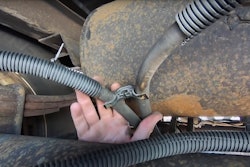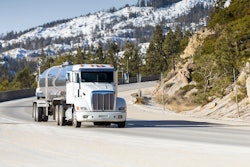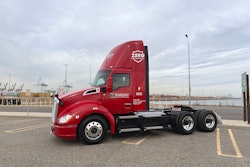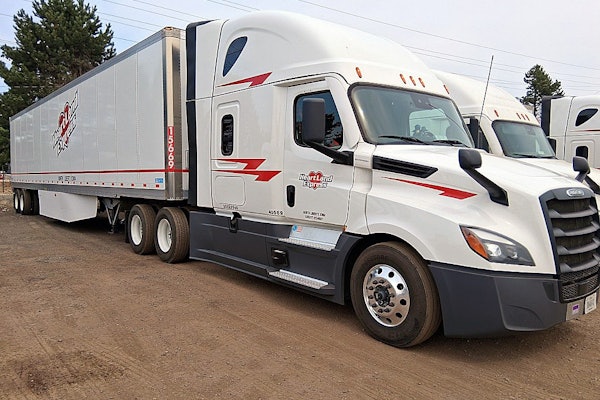Despite their collective impact on air quality, the Environmental Protection Agency regulates nitrogen oxide and particulate matter emissions independently. In this week's 10-44, Jason and Matt are joined by Chevron Lubricants Senior Staff Engineer Shawn Whitacre to discuss why, and which truck systems have the greatest influence on the various types of diesel engine emissions as more strict air quality and emission regulations loom over the trucking industry.
Contents of this video
00:00 Diesel emissions02:14 Combustion, emissions, and particulate matter
04:00 NOx and particulate matter
07:32 Engine compliance
09:01 New oil formulation standards
Jason
This week's 10-44 is brought to you by Chevron Delo 600 ADF ultra low ash diesel engine oil. It's time to kick some ash. Soot, nitrogen oxide, hydrocarbons, carbon monoxide, let's take a closer look at diesel emissions, because emissions have, and will continue, to drive the evolution of trucks. Hey everybody, and welcome to the 10-44, a weekly web episode from the editors here at CCJ. I'm Jason Cannon, and my co-host, on the other side, is Matt Cole. The amount of sulfur in diesel fuel is directly linked to the amount of pollution produced when the fuel is burned in an engine, and I know that because I got it directly from the EPA. And the government absolutely cannot be wrong, but since most diesel fuel is marketed as ultra-low sulfur, why are we in this perpetual state of diesel engine refinement when it comes to emissions?
Matt
Pollution from diesel exhaust includes soot or particulate matter, oxides of nitrogen, NOx, which contributes to the production of smog, hydrocarbons, and carbon monoxide. You've probably heard all those words several times over the course of the last several weeks, as we've seen EPA action and proposals that seek to slash NOx and soot levels in the near future.
Jason
Emissions is kind of a blanket term that covers a lot of things, basically, everything that comes out of the exhaust stack. We've invited Shawn Whitacre, who's senior staff engineer with Chevron Lubricants, to join us again this week on the 10-44 with the hope that somebody that's as smart as he is can explain to the rest of us why NOx and particulate matter are regulated separately and what all this means for clean air and the fleets that buy and drive diesel trucks.
Shawn Whitacre
There's sort of various reasons why they're independently regulated, but they're actually very different species and have kind of different effects in terms of environmental impacts and health impacts and so forth. From the standpoint of nitrogen oxides, carbon monoxide, and hydrocarbons, many of those are sort of gaseous in nature, so they're in the exhaust as a gas. They have to be measured in a certain way, and that's a little bit different than the particulate matter, which is effectively a solid. And so, those have to be measured in a different way. They're actually captured on a piece of filter paper and weighed after the test, which is measuring the emissions.
Matt
Combustion itself is basically a science project that's happening as it's rolling down the road at highway speed. That combustion is never fully efficient, so you get emissions. So in terms of a science project, it's not as clean as little Suzy's baking soda volcano.
Shawn Whitacre
You've got the intake valves, which are sucking in the clean air, which is where we access the oxygen. Air roughly is about 79% nitrogen, 21% oxygen, and it's the oxygen that we're going after, but can be the nitrogen itself can be problematic. Because it can participate in oxidation reactions as well in cylinder, which does create the Nox. But then, a certain point in the process, the fuel is injected. Of course, in the diesel engine, we're taking advantage of compression ignition. There's no spark, so we're compressing that mixture of fuel and air to allow the oxygen to react with the hydrocarbons in the fuel, ideally to go completely to things like carbon dioxide and water.
But because that combustion reaction doesn't always happen completely efficient, there can be sort of incomplete combustion. There can be creation of other species, like carbon monoxide. Some of that fuel doesn't burn and gets emitted as hydrocarbon, and some of it sort of partially burns and mixes with other things that get into the combustion chamber, like the lubricating oil, and form a solid particulate matter, which historically has been observable as the black smoke that was emitted from older diesel engines. And so, it's kind of those combination of things that ends up in the tailpipe and then, becomes the job of the aftertreatment systems to further reduce.
Jason
As emissions leave the engine, they make a few stops first. The diesel particulate filter, which captures the particulate matter, and the SCR system, which converts nitrogen oxide emissions to nitrogen, so they can be emitted as a less harmful species with the help of a dose of death over the SCR catalyst. The challenging thing with this entire process is that, often, the effects of reducing one element can have a less desirable effect on the others.
Shawn Whitacre
The interesting thing about NOx and PM historically is that they're always a bit of a trade off. Some of the things that you can do on the engine itself, in cylinder, if you're doing it to help improve nitrogen oxide emissions, it's usually at the expense of higher particulate matter emissions. One of the things before after treatment systems became pervasive for meeting NOx standards was modifying the injection timing. So retarded injection timing usually led to lower nitrogen oxide emissions, because it changed the combustion temperature inside the cylinder. But that, oftentimes, came with increased particulate matter emissions.
Because we have very sophisticated emission control systems now that can independently control these pollutants after the fact and do so in the tailpipe, we can kind of reoptimize the combustion to readvance injection timing. That actually comes at the expense of higher sort of nitrogen oxide engine out emissions, lowers the PM, and allows them to be controlled in the tailpipe. The other advantage to that is it's also beneficial in terms of fuel efficiency. It's really sort of a whole systems approach, that's utilized to lower these, and it's kind of taking into consideration the relative efficiency of the emission control systems, the impact it has on the efficiency of the engine itself, the fuel economy, and the regulated levels themselves.
Matt
EPA's more stringent NOx regulations will impact model year 2027 trucks. So if you're buying new trucks this year, you'll probably have to deal with this on your next trade cycle. The good news is, the obligation to meet the new standards lies on the OEM, but there are things fleets are responsible for to remain compliant. Shawn tells us what those are after a word from 10-44 sponsor, Chevron Lubricants.
Protecting your diesel engine and its aftertreatment system has traditionally been a double-edged sword. The same engine oil that is so essential to protecting your engine's internal parts is also responsible for 90% of the ash that is clogging up your DPF and upping your fuel and maintenance costs. Outdated industry thinking still sees a trade off between engine and emission system protection, and Chevron was tired of it. So they spent a decade of R&D, developing a no compromised formulation. Chevron Lubricants developed a new ultra-low ash diesel engine oil, that is specifically designed to combat DPF ash clogging.
Delo 600 ADF with omnimax technology cuts sulfate ash by a whopping 60%, which reduces the rate of DPF clogging and extends DPF service life by two and a half times. And just think what you can do with all the MPGs you're going to add from cutting your number of regions, but Delo 600 ADF isn't just about after treatment. It provides complete protection, extending drain intervals by preventing oil breakdown. Before, you had to choose between protecting your engine or your after treatment system, and now, you don't. 600 ADF from Delo with omnimax technology, it's time to kick some ash.
Shawn Whitacre
The actual regulated entity in most cases is the manufacturer themselves, so they're the ones that are sort of on the hook to make sure that these engines and vehicles are compliant with the standards. And there's very rigorous protocols by which they have to test that and demonstrate that to EPA or CARB or whoever the particular regulator is in that particular instance. There are things that the end user can do though, and it's a requirement as part of their operation. And there are even controls in place within the engine to ensure that the end user is doing their part. It's things like making sure that you're utilizing proper fluids. Here in the US, you have very ready access to ultra low sulfur diesel. That's really no longer a complication, in terms of compliance.
Making sure that the diesel exhaust fluid tank is full and that you're using kind of onspec product, because if you're just using water, trying to trick the system, there's ways that it can figure that out as well. Utilizing the proper lubricating oil is also kind of pivotal in making sure that these systems remain compliant, but then, also, I think there's really direct benefits to the user themselves. Using low ash oils helps keep the DPF system clean, helps it reduce the frequency at which there are regeneration events, as well as kind of reduces the overall fuel consumption over time.
Jason
Shawn mentioned proper lubrication, and we discussed on a previous episode of the 10-44 with him that engine manufacturers have already asked oil developers to start work on a next generation engine oil with lower viscosities and newer formulations. That episode aired before the EPA finalized its new standard in late December, but now that lube formulators know their official and firm targets, Shawn says that work can continue, but now in earnest.
Shawn Whitacre
Our next meeting with that team is coming up in February, and we'll continue the discussion with all those stakeholders, still with an eye towards launching PC-12 compliant fluids in the late 2026 timeframe. So it'll be ready for the 2027 model year. It just kind of gave us better certainty around the timing of the standards, as well as how strict they're going to be. We've kind of had some notional ideas about both those aspects and then, now that it's kind of set in stone, I think it really allows us to move forward with certainty about the particular requirements. To a large extent, they're very well aligned with CARB standards, and I think that helps just from ease of compliance.
And you're not sort of developing products that have to meet a much tighter standard for sale in the states where the CARB standards prevail. But no doubt, there are going to be significant challenges, because they are significantly lower than today's standards and also, have a compliance expectation or useful life expectation that's longer than today. So a big challenge is ahead, but I think the industry has a very good track record of meeting those kinds of challenges and delivering on the clean air goals that the standards demand.
Jason
That's it for this week's 10-44. You can read more on ccjdigital.com, and as always, you can find the 10-44 each week on CCJ's YouTube channel. And if you've got questions, comments, criticisms, or feedback, please hit us up at [email protected] or give us a call at 404-491-1380. Until next week, everybody, stay safe.











